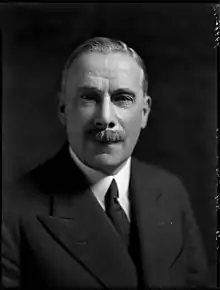George Tryon, 1st Baron Tryon
Major George Clement Tryon, 1st Baron Tryon, PC (15 May 1871 – 24 November 1940) was a British Conservative politician who served in a number of ministerial positions in the inter-war years.[1]
The Lord Tryon | |
|---|---|
 | |
| Chancellor of the Duchy of Lancaster | |
| In office 3 April 1940 – 14 May 1940 | |
| Prime Minister | Neville Chamberlain |
| Preceded by | William Morrison |
| Succeeded by | The Lord Hankey |
| First Commissioner of Works | |
| In office 18 May 1940 – 3 October 1940 | |
| Preceded by | The Earl De La Warr |
| Succeeded by | Sir John Reith |
| Personal details | |
| Born | 15 May 1871 |
| Died | 24 November 1940 (aged 69) Little Court, Sunningdale |
| Spouse(s) | Averil Vivian |
| Children | 2, including Charles, 2nd Baron Tryon |
George Clement Tryon was son of Vice-Admiral Sir George Tryon and Clementina Heathcote, daughter of Gilbert Heathcote, 1st Baron Aveland.[2] Educated at Eton College and the Royal Military College, Sandhurst, Tryon joined the Grenadier Guards in 1890, serving for sixteen years before retiring as major.[2]
Tryon was elected as Member of Parliament (MP) for Brighton in 1910, serving until 1940. He became Under-Secretary of Air in 1919 and Parliamentary Secretary to the Ministry of Pensions in 1920 and in 1922 became a Privy Counsellor. He served as Minister of Pensions himself 1922–24, 1924–29 and 1931–35 and was then appointed Postmaster General in 1935, serving until 1940. He was one of those to appear on the first day of BBC television broadcasts, 2 November 1936.[3]
In April 1940, Tryon was elevated to the peerage as Baron Tryon, of Durnford in the County of Wilts[4] and made Chancellor of the Duchy of Lancaster and First Commissioner of Works. However, he was replaced as Chancellor (by Lord Hankey) when Winston Churchill became Prime Minister in May, while retaining the First Commissionership; he relinquished that post the following October, a few weeks before his death, aged 69.
He married Averil Vivian, daughter of Colonel Sir Henry Hussey Vivian, 1st Baron Swansea. They had two children, including Charles, 2nd Baron Tryon.
Coat of arms
 |
|
References
- "Tryon, 1st Baron". Who Was Who. Oxford University Press. December 2007. Retrieved 18 July 2011.
- 'Lord Tryon: Unselfish political service' (obit.), The Times, 25 November 1940, p. 7
- BBC. "The Contest". The BBC Story. Retrieved 1 October 2013.
- "No. 34834". The London Gazette. 23 April 1940. p. 2383.
External links
- Hansard 1803–2005: contributions in Parliament by George Tryon
| Parliament of the United Kingdom | ||
|---|---|---|
| Preceded by Ernest Villiers Aurelian Ridsdale |
Member of Parliament for Brighton 1910–1940 Served alongside: Walter Rice 1910–1911 John Gordon 1911–1914 Charles Thomas-Stanford 1914–1922 Cooper Rawson 1922–1940 |
Succeeded by Cooper Rawson Lord Erskine |
| Political offices | ||
| Preceded by Ian Macpherson |
Minister of Pensions 1922–1924 |
Succeeded by Frederick Roberts |
| Preceded by Frederick Roberts |
Minister of Pensions 1924–1929 |
Succeeded by Frederick Roberts |
| Preceded by Frederick Roberts |
Minister of Pensions 1931–1935 |
Succeeded by Robert Hudson |
| Preceded by Sir Kingsley Wood |
Postmaster General 1935–1940 |
Succeeded by William Morrison |
| Preceded by William Morrison |
Chancellor of the Duchy of Lancaster 1940 |
Succeeded by The Lord Hankey |
| Preceded by The Earl De La Warr |
First Commissioner of Works 1940 |
Succeeded by Sir John Reith |
| Peerage of the United Kingdom | ||
| New creation | Baron Tryon 1940 |
Succeeded by Charles Tryon |
.svg.png.webp)